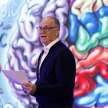
FROM THE 15 COMMITMENTS OF CONSCIOUS LEADERSHIP. (DETHMER, CHAPMAN, WARNER KEMP)
When we think about consciousness and unconsciousness we normally think of states of engagement with the world. Consciousness referred to as “the hard problem” in philosophy is defined as our ability to have a sense of self and engage with the world. Unconsciousness is the lack of engagement and responsiveness to other people and the environment. When people are unconscious they lose their awareness of what is happening around them.
When we describe a leader as unconscious what we mean is that they are reactive to a story from their past or an imagined future where their personality or ego takes over. Rather like Carol Dweck’s fixed mindset, they do not lead from a creative impulse or from what is happening in the moment.
This is perhaps why many (unconscious) leaders are often associated with “anger issues;” they can’t see what is happening. Most change is viewed as a threat to their status and ego and therefore their behavior becomes a defensive reaction to defend their position. They often attach blame to circumstances outside of themselves or other people and there is a lack of responsibility for events. Fear kicks in.
Conscious leaders, whilst much less common, live in the moment and respond to what is happening around them. They are prepared to take on new patterns of behavior, which frees them to lead and serve others. But this is rare.
Above the line and below the line.
One of the key concepts in conjunction with the Four Ways of Leading is the idea there is a line that separates two main ways of being.
Above the line is open, curious, and committed to learning. This is where creativity, innovation, and collaboration (the keys to high-level problem solving) occur best.

Below the line is - closed, defensive, and committed to being right. “When we perceive a threat to our sense of well-being, we go “below the line”. We don’t choose this on a conscious level. We just do it. We close down. We get defensive and double down on being RIGHT”.
The Four Ways of Leading.
No model can really do justice to the complexities of reality, particularly when we are speaking about consciousness and unconsciousness. A wine label is not the wine itself but it can act as a pointer to the contents of the bottle.
The four ways of leading are ways of being. They are states of behavior and we move in and out of these states throughout the day. Rather than a hierarchical structure, like Maslow’s hierarchy of needs, these are states of being, not states of development.
TO-ME - LIFE HAPPENS TO ME.
The state of To-Me is a below-the-line mindset and is probably where 95% of leaders (and most of us) spend 98% of our time.
In this state of consciousness, we see ourselves as “at the effect of” something outside ourselves. We are being acted upon by outside forces. Even the cause of our well-being is at-the-effect-of some external factors.
This is a “victim consciousness.” This doesn’t necessarily mean that we are actual victims; some people are victims of external forces, such as the children of alcoholics. However, according to Dethmer, Chapman, and Klemp, we only live a victim consciousness if, thirty years later, we still blame our parents for our suffering and problems.
To-Me will assign blame to the past for current experiences. We may fault ourselves, others, circumstances, or conditions for what is happening. We are dominated by questions such as, “why did this happen to me?” and “why don’t they respect me?” and search for ways to assign responsibility for the cause.
The desire to be seen to be “Right” is predominant. This often follows a threat, either to the physical situation or to the ego. It is a below-the-line consciousness.
Posture: Victim.
Experience: Blaming and complaining.
Beliefs: There is a problem. Someone is at fault. Someone should fix this.
Key question: Why me? Whose fault is this?
Benefits: Experience separateness. Defined identity. Entertaining drama. Supports empathy. Adrenaline high.
BY-ME - I MAKE LIFE HAPPEN.
When we shift from below-the-line to above-the-line we shift from To-Me to By-Me. From victim to creator. We are now in a state of “consciously creation with.”
This state sees everything unfolding perfectly for their learning and development. We are aware of what is happening around us. We choose curiousness and learning over defensiveness and being right. In this state of consciousness, we ask questions like “what can I learn from this?” At this point, we are choosing to take responsibility for whatever is occurring in our lives and not blaming any outside forces or conditions.
Posture: Creator
Experience: Appreciation.
Beliefs: Problems are here for me to learn from. I create the problem, so I can solve it.
Key question: What can I learn? What do I want to create?
Benefits: Personal empowerment. Define your wants and desires.
THROUGH-ME - I COOPERATE WITH LIFE HAPPENING.
In this state, we see ourselves as the center of consciousness without excluding other people or causes. This mindset is consciously creating with other people, circumstances, and conditions. It is interested in learning and is empowered and, as a result, curious. Here we notice thins beyond ourselves. Here we may ask; “What is the highest idea of itself that wants to manifest in and through me?”
Through me leaders do not try to “figure out” their answer; they listen attentively to what wants to be communicated to them.
As responsibility is the gateway to move from To-Me to By-Me; surrender or letting go is the gateway to move from By-Me to Through-Me. This often means letting go of control. This may feel chaotic and powerful.
When we are in a To-Me state, we experience very little control because we are “at the effect of” what is happening. When we are in a By-Me state, we experience power and control in a place of responsibility, creativity, and ownership.
Posture: Co-creator
Experience: Allowing, flow, wonder, and awe.
Beliefs: I am the source of all meaning. I experience things as perfect, whole, and complete. Life handles all apparent “problems.”
Key question: What wants to happen through me?
Benefits: Non-attachment. Unlimited possibility, plenty of everything.
AS-ME - LIFE IS ME.
As-Me consciousness is manifested least often, and has two aspects. The first is Oneness where there is no separation and only one reality. The second aspect is the absence of a personal “me.”
In the first aspect, Oneness, there is only direct experience and that experience is completely congruent and consistent with who they are.
In the second aspect, no personal “me”. Dethmer,, Chapman and Klemp explain that in this state, where there is no “me” there is, therefore, no you to have a problem. This state is unique and, it seems to me, is related more to spiritual leaders and thinkers than to business leaders. This is more concerned with being completely in the moment with no duality or difference between thought and action. Purpose and the individual are one and the same.
Posture: At one with all.
Experience: Peace and spaciousness
Beliefs: There is just oneness. There are no problems, and no one to “solve” them.
Key question: No more questions, knowingness.
Benefits: Experience of oneness & non-dualism. Unlimited freedom & peace.
We all move between the various states, from To-Me to Through-Me and back to To-Me often in a matter of moments.
Conscious Leadership works as a conceptual framework for understanding the impact leadership has on those who follow. The interaction of the leader and the follower form a dynamic and fluid relationship where motivation, inspiration, and innovation are intertwined, from action to reaction in the creation of new action and new behavior.







Comments
There are no comments for this story
Be the first to respond and start the conversation.